Celebrating 40 years of Saddlebreds … The Royal Scot Story
Thursday, August 9, 2007
by Ann Bullard
It all started with a canny Scot: a man whose curiosity and sense of adventure brought him from his homeland on the mist-shrouded island to New Orleans and finally to Illinois. The Scotsman transformed an observation into an idea and turned that into a company that would become the worldwide leader in its field.
There was little in Robert Fergusson’s early life that would lead one to believe he would achieve such heights. Like many a young Scot, he took to the sea when a young man of 15, serving as a cabin boy and then an apprentice seaman in clipper and early steam ships. While serving on a whaling vessel, he first noticed the rust-inhibiting characteristics of fish oil.
Fergusson braved high seas and storms in his journey from simple seaman to ship’s captain. For almost two decades, he had tested various formulas of his rust-inhibiting paint – and had fallen short of his goal. The turning point came after World War I, when the U.S. Maritime Shipping Board employed the captain as custodian of its laid-up World War I Victory Fleet just outside of New Orleans. It provided him with an ideal laboratory. Continuing experimentation enabled him to produce a product that eliminated the ‘fishy smell,’ a main objection to fish-oil paints.
In the early 1920s, Fergusson began selling a clear, rust-inhibiting base coat. Still, he knew producing a colored product was essential to his success. He ground various pigments, mixing them into his formula. The sight of the retired captain driving his old Ford roadster, sporting black, red, green and aluminum-painted panels, became a familiar one on the city’s streets. From that small storefront near downtown New Orleans, he and his family built his Anti-Rust Paint Company into the international giant Rust-Oleum Corporation.
Fergusson’s life was dedicated to his God, his family and the ‘mechanical world.’ He and his wife, Ellen, married in 1881 and she made several trips on ships he captained across the world. Their two sons, Robert Archibald and Donald Wilson Fergusson, began their lives in a small house in uptown New Orleans. That their descendents would establish one of the leading American Saddlebred and Hackney Pony operations in their parents’ adopted country never crossed their minds.
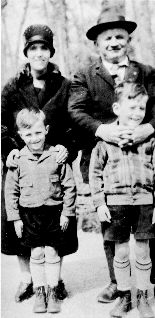
The legacy began with the Scottish sea captain,
Robert Fergusson. He, his wife, Ellen, and sons,
Don (left) and Robert lived in a simple home in
New Orleans while he developed the formula
that would become Rust-Oleum.
In her quiet way, Ellen Fergusson was as strong a personality as her husband. While he traveled first at sea and later across the country selling his paint, the primary responsibility for raising their sons fell to her. She remained in New Orleans when the company made its initial moves to Ft. Worth, Texas and Chicago, Ill.
During their grammar school years, the boys often traveled with their father, catching his enthusiasm and sharing in his dream. Donald Fergusson was 12 when the family moved to Chicago. He and his brother continued to work with their father, following the administrative side of the business and his younger brother heading the technical and manufacturing side. The brothers still were boys when their father died in October 1940. Rust-Oleum ownership passed to his wife, who gave her sons’ unrestricted authority to operate or dispose of the business.
“My husband was 18 and his brother 20 when their father left them the business to sink or swim,” Marge Fergusson said, explaining she had met her future father-in-law only once before his death. “The boys decided Bob would go in the Army first, leaving Don as his mother’s dependant and to help run the business. His mother died in December 1944 and we married the following February. On March 1, he got his draft notice.”
Although Marge Fergusson had met the captain but once, she soon became part of the family business. “I was right out of high school. They had a little retail store [and office] in Evanston, Ill., where they needed office help. I didn’t know anything.”
Still, she handled sales and some basic bookkeeping from that one-person office. Her two brothers joined in the operation at various times after World War II.
None of the Fergussons had “been near a horse or a barn” until their daughter, Jeanne, was a teenager. “You know how girls are: first they want to do ice skating, ballet, this and that,” Marge Fergusson said. “A couple of her friends wanted to take riding lessons. We lived about three to four miles from an old barn. Jeanne wasn’t old enough to drive so I took her to lessons with Don Peebles two to three times a week. She first showed in a class somewhat like academy; fortunately [or unfortunately] she won that class. It was sort of the beginning of all of this.”
The Fergusson passion and single-mindedness manifested itself in Jeanne through the horses. She had to sell her father on the sport, one he later embraced wholeheartedly.
“My husband didn’t even want her being around the barn,” Marge Fergusson said, recounting the family tale. “He fought that for a couple of years. We had never been to a show until Jeanne started going to some of the little ones and winning. We bought our first horse, a black Quarter Horse Jeanne named Ringo, when we were at the Peebles. He turned out to be a wonderful horse that lived to be over 20. He got us into the business before we ever had an American Saddlebred.”
Don Fergusson recognized Jeanne’s passion – and set about getting in the horse business in a most organized way. Jeanne showed Ringo and the family’s first American Saddlebreds, Kimberland’s Misty Maid and CH Arabesque (BHF), from Peebles’ stable. In the summer of 1966, the Fergussons decided to ‘go into business.’ With that goal in mind, they moved their horses to Chat Nichols in St. Charles, Ill. The rest of the year, Fergusson studied Saddle Horse operations.
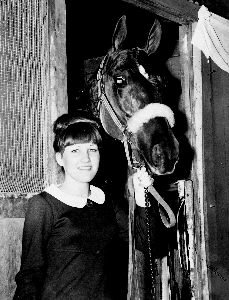
Marge Fergusson’s husband, Don, selected
CH Arabesque (BHF) as one of his daughter,
Jeanne’s, early Saddlebreds. She showed the mare
successfully before Arabesque began her second
career as a Broodmare Hall of Fame mare.
As early as 1966, he began establishing guidelines and a business plan that moved the family ‘hobby’ into a business enterprise. A year later, the Fergussons purchased a 120-acre dairy farm. Cecil Perrin assumed the young horse training duties at the remodeled hog barn while the show stock remained with Nichols. The Fergussons incorporated Royal Scot Farms on March 15, 1968.
“I felt we needed some time to study the situation,” Don Fergusson wrote in his detailed history of Royal Scot Stables. “We came to the conclusion that the only way we could make this business pay was to hire our own trainer and bring all of our horses under one roof.”
Nichols rejected the opportunity, but continued to work with the Royal Scot horses until a new barn was built and trainer hired. After Fergusson’s considerable study of different training barns and meetings with several builders, construction began in December 1969.
Fergusson took the same hands-on approach in building Royal Scot that he did with Rust-Oleum. No detail was too small. He scrapped the original plan to redo the cow barn, but had it torn down and started over. Barn cleaners, such as he had seen at Ruxer Farm, angle iron and barn construction ranked alongside the company in his conversations.
Fergusson’s inviting a young man who worked part-time at Rust-Oleum while attending school helped set the family on their current path. Tom Pettry lived in Wauconda, near Richmond, Ill., while attending the American Academy of Art School in downtown Chicago. He became part of the ‘tear down and rebuild’ crew at the farm. Until then, horses had played no part in his life.
“The old dairy farm was pretty well run down. We tore it down and converted buildings one at a time. Jeanne would paint fence boards when she and Don came up on weekends,” Tom recalled. “I watched her for a year or so before finally asking her out. One thing led to another.”
Jeanne says she knew Tom was the man for her “when I saw him up on the roof working with the carpenter. He became pretty handy.”
They were married a year later, in 1971.
While the barn was under construction, the Fergussons interviewed trainer candidates. Bonnie Byrne was one of the approximately 20 persons under consideration.
“My father, Hugh Byrne, had a basic training stable in Aurora, Ill.,” Byrne said from her home on Sanibel Island in Florida. “My good fortune was that we had outstanding trainers in the area. Tom and Donna Moore, Dick and Jeannette Durant and Chat Nichols were my mentors.”
Byrne had completed college and taught school for a year before deciding to try the horse business. She opened a small barn in Champaign, Ill., taking a few horses to the Chicago International.
“The Fergussons had interviewed some very good people, but none were available. They were anxious to get the stable open to give Jeanne something to be involved with. It was Jeanne’s passion. They thought I would be a good combination with her,” Byrne said, crediting Jeannette Durant’s telling her she’d “have rocks in my head if I didn’t take the Fergusson job” with helping finalize her decision.
Byrne was 24-years-old when Royal Scot Stable opened in 1970. Only about half the stalls were complete when she moved in with five horses: Victory Serenade, Busy Agent, a three-year-old five-gaited colt and a pair of yearlings.
“I knew the Fergusson family as we had shown on the same circuit,” Byrne said. “Although I wasn’t proven professionally, I had a lot of confidence. Hiring me was a big step for them.”
Royal Scot hit the show ring in winning style, earning ribbons in each of the 14 classes in which they competed at the Illinois, Indiana and Kentucky State Fairs. Byrne and Busy Agent won the Illinois State Fair Ladies Five-Gaited Championship, the Ladies Five-Gaited Gelding World’s Championship and a reserve in the Ladies Five-Gaited Grand Championship that year.
She spoke of her initial reaction to the business plan. “Mr. Fergusson called me in one day and told me how we were going to plan for profit years. He said, ‘Here is a five-year plan.’ I had never taken any business in school. Being a horseman, I thought ‘this is ridiculous; how do you plan to sell ‘x’ dollars of horses.’”
A look at that business plan shows some interesting contrasts with the cost of doing business today. Income projections for 1970 pegged board and training of five horses at $200 per month and breeding revenue for 15 mares at one-half the $350 stud fee. Salaries for the manager/trainer and one groom totaled $18,000 for the first year.
“We worked toward it and it worked pretty well. We raised some nice young horses. Jeanne showed them in ladies and amateur competition to help sell them,” Byrne said. “Jeanne was about four-years younger than I. She had a lot of natural ability and looked good on a horse. She married Tom pretty early-on after I was there and became involved with raising children.”
Children did limit Jeanne’s time at the farm. However, she continued to show – and win – after Donna and Kristen were born.
In 1973, CH Tartan Twilight, the yearling colt whose personality had impressed a young Tom Pettry, won the Five-Gaited Pleasure World’s Championship with Jeanne in the irons.
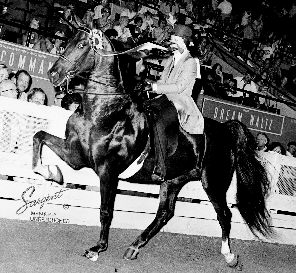
Jeanne and CH Tartan Twilight won a Five-Gaited
Pleasure World’s Championship early in their career.
The Tartan Twilight Trophy has been given to the
Five-Gaited Pleasure World’s Champion of Champions
for decades.
In 1982, she teamed CH City Glitter to win the Five-Gaited Amateur Mare World’s Championship and continued to earn top ribbons with the mare until CH City Glitter was retired to the broodmare band.
Don Fergusson spent most weekdays at the office. Weekends meant time at the farm.
“He would do anything,” Byrne said. “He and Marge planted all the trees around our manmade lake. He would mow hay. He always enjoyed watching the horses work and being with our customers. On Saturdays, everyone would have a fun morning riding and driving, go to lunch at a local restaurant and might fish in the stocked lake in the afternoons.”
Marge Fergusson handled all the bookwork. It wasn’t long until Byrne and Don decided to ‘get her’ into driving. While Marge initially showed fine harness, ponies became the spot at which she shined.
“We bought Tijuana Brass from Bill Robinson,” Byrne said. “Don had gotten into driving that winter and, since Brass was a stud pony, we decided he and Don might be a better combination. He did a wonderful job and loved it. A year or two later, we bought Dun-Haven Inspiration for Marge.”
The 17 Byrne years were great ones for Royal Scot. The business evolved from being simply a training and boarding operation into a heavy breeding program. At one time, all their great show mares became part of the broodmare band. Among the mares the Fergussons purchased was the Broodmare Hall Of Fame’s Dreamhill’s Ann Thompson, dam of CH Epcot Center and CH Citibank and granddam of CH Epcot’s Treasure. Tijuana Brass progeny bred by the farm included Brass Lass, Tijuana Trumpet, Tijuana Starlet, Texas Tommy, Brass Buttons and Mr. Hawkeye.
Byrne has some treasured memories of those Royal Scot days. “From a show standpoint, the first time Don showed Tijuana Brass at Tampa stands out. It was at the Tampa Yacht Club; watching them drive around that shell and stone ring was so pretty … Jeanne’s first blue with CH Victory Serenade is another. It was their first year out and I was pretty nervous. I was watching Jeanne and the horse and didn’t pay much attention to the rest of the class. I think some trainer poked me and said he thought Jeanne was winning the class.”
CH Tartan Twilight’s Louisville win ranks at the top of Byrne’s list. The Fergussons had bought him as a youngster, raising him at the Illinois farm. That 1983 win had parents, rider and trainer in tears.
While the horses were important to Byrne, the personal memories are those she treasures most. “I loved Christmas at [the Fergussons’] home. We got together on Christmas Eve. Christmas morning and evening were very festive. Marge’s mother, father, aunt and grandmother were there. We used to play Hearts or Spades around the kitchen table on weekends.”
Mary Jo McAbee worked for Don Brockman before coming to Royal Scot. “When we went to shows, I looked around to see where there might be another place I could go. Royal Scot looked so organized, so neat and clean. I remember thinking the Kentucky barns were all splash and dash. When you saw them in person, it was a big let down. Royal Scot was a classy place.”
McAbee joined the Royal Scot team as a caretaker when Byrne came on board. She worked her way from caretaker to assistant trainer.
“A very unique man.” That’s the way McAbee described Don Fergusson when she looked back on her 30-year association with Royal Scot. “I laugh because he was so hands-on. He would change the oil in the tractor and fix this and that. I can remember being in there cleaning stalls. It could be 100-degrees and he would come in and say, ‘I hope we’re all having fun, because if we’re not we’re not going to keep doing this.’”
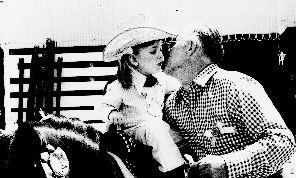
Don Fergusson died before he could see Royal Scot
Stables and his grandchildren reach dreamed-of
heights in the American Saddlebred world.
He helped Donna get her career on track
by leading her on her first pony, Trix,
at the 1975 Midwest Horse Show.
“I had two children while I was working there,” McAbee said. “They did everything they could to be sure I could keep on working.”
McAbee emphasizes that Royal Scot has always “been about the horses. They were so conscious of what a horse needs and how long it could take to grow up. It made it such a great environment.”
While McAbee no longer is formally associated with Royal Scot, she, Marge Fergusson and the rest of the family remain good friends. She lives on a farm in Illinois where she can look out and see Protégé in her field.
Having adopted Jeanne’s passion as his own, the senior Fergusson became a fixture in the winner’s circle, particularly with his World’s Champion Tijuana Brass. He was on the lines with his long-tailed star at the 1976 Illinois State Fair when he died. Cards had already been turned in; Tijuana Brass had won the blue.
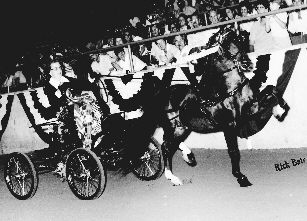
Marge Fergusson took over the reins with
the many-times World’s Champion Harness Pony,
Tijuana Brass after her husband’s death.
From the time the Fergussons first considered getting into the horse business until Donald Fergusson’s death; his hand was evident in every aspect of the business. However, times and priorities change. Byrne’s expertise with the horses and adult amateurs no longer fulfilled all the farm needs. Donna and Kristen needed to ride with someone both closer to their home and one whose strengths included teaching young riders.
“Grandfather knew I was coming, but I never met him,” Kristen Pettry said, explaining she was born the following August. “We didn’t live on the farm, but about an hour away. My sister and I went there to stay with Grandma on weekends. We always looked forward to that. We had a Quarter Horse and pony to ride at the farm but we mostly rode there for fun.”
Fran and Kim Crumpler trained at Valley View Farm in Barrington, Ill., a convenient commute for the Pettry girls. Their association with the Pettrys began with the girls’ riding lessons.
“Bonnie didn’t do lessons for kids; she (or Jeanne) suggested they come to Kim,” Fran Crumpler said. “One thing led to another and they decided they wanted to do more with the kids than with colts. We mutually agreed a change would be made. We went up there and all of a sudden we were family. We couldn’t have asked for a better situation.”
Kristen recalled those days. “I think I was about seven. We went a couple of days a week after school; I remember the barn was so cold. I rode this really cute horse, Follow A Dream, that had me figured out pretty quick. Valley View had a long aisle way and she would back all the way down the aisle to her stall. Every single lesson was in reverse; she probably didn’t know I was on her back.”
Kristen did get the key to that first as well as to other horses. They showed successfully in 10 and under and 13 and under three-gaited show pleasure divisions before the mare retired to the Royal Scot broodmare band.
Kim picked up the story. “They came to us for lessons and later we got the girls horses. They rode with us in Barrington for three or four years before we moved to Royal Scot. Tommy was about four, Kristen seven and Donna 10 or 11.”
The Crumplers added 16 training horses to the Royal Scot group. They sold the ponies, including Brass Lass and Texas Tommy, to concentrate on the ‘big horses.’
“Donna had Playboy’s Cabaret when we got there,” Fran said. “Her later horses included Nosy Decision and CH Fantastic Step. Kristen had Capital Gain C.W. for walk and trot. The Estimator, a horse we got from Linda Murphy, taught Kristen how to ride. He was a show horse, game and really saw things. She had to be really aggressive to ride him through it.”
“Kim and Fran did a great job for me, keeping me on appropriate horses my entire juvenile career,” Donna said. “I think I was about 15 when we bought CH Fantastic Step. He was kind of my first real fancy horse. I think he was four when I tried him; it was the first time I had ever sat on a horse that was not a kid’s horse. It was the first time I ever felt that powerful, big-motioned performance horse. I’d always had horses that were appropriate for me. I felt like – wow! This is what they love! I remember looking at his neck; he was so full of himself that I remember it shaking. It was awesome.”
Armon Effinger had the horse at the time. Donna tried him at a horse show.
“The main thing I remember is sitting on top of him when he felt like he was going to explode – but didn’t. I believe I tried some other horses after this. I wouldn’t hear of having a different one; I think Kim probably wanted to wring my neck. I just had a feeling this was the horse. He went on to be a great one for me and the whole family. We all showed him; he just had a neat vibe about him.”
He became Donna’s first performance world’s champion. They were judged the best of 17 competitors in the 1990 Junior Exhibitor 15-17 Three-Gaited Stake.
Tommy, more properly Tom D. Pettry to distinguish him from his father, began his riding career with the Crumplers. “He was maybe four or five. We always used to do leadline with Tommy. He rode Donna’s equitation horse and wore a top hat and tuxedo,” Fran recalled.
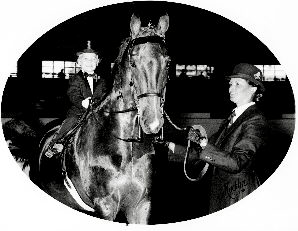
Tommy’s made his early ‘formal’ show ring
appearances in leadline classes – wearing a top hat
and tuxedo. Fran Crumpler led him on Donna’s
equitation horse, Playboy’s Cabaret.
Tommy remembers those days. “When I was little, I insisted I didn’t want to post. Kim teases me about it to this day. It probably gave me a pretty good seat, but it was strange for an eight-year-old to sit in every class.”
Kim and Fran still tell the story of Tommy’s deciding not to ride. “We overheard him tell Jeanne he didn’t feel like riding one day. She was insistent, saying everybody is going to ride. Tommy was about six; we heard him say very seriously, ‘Mother, there are millions of Americans who do not ride horses.’ We all were snickering behind closed doors but he got out of riding that time.”
After Andrew’s birth in 1983, the Pettrys’ world changed dramatically.
“Life sometimes smacks you in the face,” Tom C. Pettry said, acknowledging Andrew as a special-needs child. “You realize things are more important than a job.”
Pettry left the daily grind of corporate advertising to work from a home office and spend more time with the family. He began giving more and more time to his biggest client, Royal Scot Stables.
Andrew struggled with health issues throughout his early years. By the time he was seven, his family realized that a change to a drier, hotter climate was essential for him. They looked to Tucson, Ariz., as their new home. Tom went out to look around.
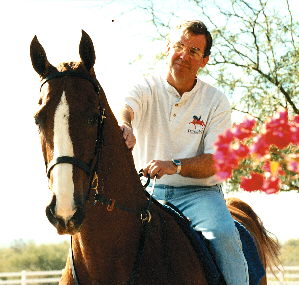
Tom Pettry occasionally showed in harness
but not under saddle. He did enjoy riding CH Olivier
on the Arizona farm – and teaming him to
championship honors in the pleasure driving division
Fran Crumpler recalled that time. “Jeanne got us plane tickets to Tucson. They showed us the property and asked ‘Where would you build the barn?’ Kim looked at that desert land and said, ‘Illinois.’ He and I had older parents living there and we felt there was no way we could live way out west.”
Little things stick out with Fran. “Dying Easter eggs … Marge and I going to the little Methodist Church in Ringwood … those are some of the things I’ll never forget. We all went out to dinner at a local restaurant on Friday nights. Being around the family always was wonderful. They go out of the way to make you feel special. The family thinks about other people as much as anyone I’ve ever known.
As the family prepared to move to Arizona, they sent their horses to Tom Galbreath’s Castle Hills Farm in Lexington, Ky. Once again, it was the start of a magical time.
The early 1990s might be called the heyday for Royal Scot Stables. Pat McConnell, later assisted by Steve Wheeler and Tony Ray, took over training the performance horses.
“Pat took my riding to the next level,” Tommy said, pointing out this is when he was older and started riding performance. “He taught me how to have fun, as well as how to push and get the most out of a horse.”
McConnell had never visited Arizona until he went to work for Royal Scot in the winter of 1993. The family and their horses wintered in the desert, returning to Illinois for the spring, summer and fall. He remained with Royal Scot until February 1997.
“Tom did a beautiful job designing that barn,” McConnell said. “It couldn’t have been any better. We brought 35 to 38 young and show horses plus lesson horses there every year. Mary Jo [McAbee] stayed home with the broodmares and babies.
“I put Tommy in his first canter class aboard CH Epcot’s Treasure at Carousel in March 1994. When I left, Donna had aged out of juvenile. Kristen was near the end of her junior exhibitor career, showing such horses as CH Iron Will and CH Fantastic Step. Tommy had added Chief’s Magnum Force [now showing as CH The Society Gentleman] to his string of horses.”
The Royal Scot name has been associated with so many great horses, it’s hard to enumerate them. One in particular stands out – not only because CH Starfire Fox was a great pleasure horse, but because he had the disposition to be ‘Andrew’s horse.’ Andrew rode him almost every day the family was in Arizona.
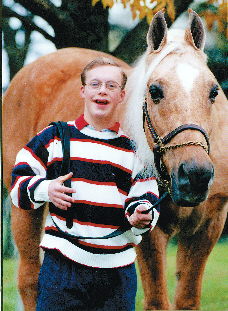
Andrew and CH Starfire Fox graced many a
leadline class. The youngest Pettry considered
the multi-titled palomino gelding ‘his horse.’
Starfire Fox seemed to share the feeling.
Few people who watched Donna gallop from the ring at the end of her victory pass aboard the charismatic palomino after winning Western Finals at St. Louis will forget her smile. Yet the horse who won the Working Shatner Finals in 1993 and ’97, the Christine Shaw Hunter Pleasure Finals in 1994, the Western Country Pleasure Championship in 1995 and countless other hunter and western classes before and after those dates embodied the best of the American Saddlebred. He was a horse that loved to be loved.
“Trigger was real special,” Donna said. “We kept him with Nealia [McCracken] for a year as I had never ridden western. She taught me everything. I took him to Arizona with me.
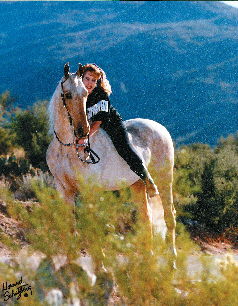
CH Starfire Fox was a winner in western and
hunter country pleasure with Donna and Kristen.
He and Donna enjoyed trail rides around
the Tucson, Ariz., area farm.
“He was a neat horse and the first one I ever worked myself and showed,” she continued. “Kristen and I both showed him. At St. Louis, we usually would take him and perhaps one other horse. We’d show in six to eight classes. We’d have one stall, one tack stall and about eight ribbons. We ended up taking him by ourselves two or three years in a row. We’d show all week and always ended up winning something.”
The year 1995 was another good one for the Pettry youngsters and the Royal Scot team. None fared better than Kristen, winner of the American Royal Equitation Championship for the second consecutive year. From their season opener at Oklahoma City through Winterfest in December, Kristen and CH Fantastic Step had a year to match his name. She and Stay Gold earned a reserve world’s championship in the junior exhibitor 15-17 age group. Horse World voters named Kristen their People’s Choice Juvenile Rider of the Year for the second year in a row.
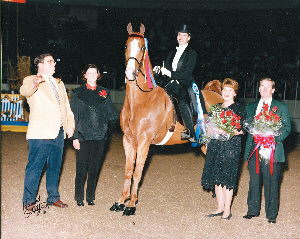
Jeanne and Tom Pettry and trainers Fran and Kim Crumpler
joined Kristen in center ring when she won the
American Royal Saddle Seat Equitation Championship.
If ever one group had an exceptional world’s championship show, it would be the Fergussons and Pettrys in 1996. “We won eight blues and six reserves,” McConnell recalled. “All six of the reserves had a first-place vote. Mrs. Fergusson’s win in the Amateur Harness Pony Stake with Bold Lad still is one of my career highlights.”
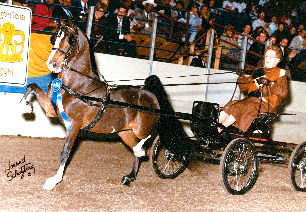
Marge Fergusson’s 1996 World’s Grand Championship
drive with Bold Lad remains one of the highlights
of trainer Pat McConnell’s career.
Each of the three Pettry riders garnered blues and/or tricolors. Donna and CH Bazooka Joe rode off with the Five-Gaited Pleasure World’s Championship tricolor after a reserve in the qualifier. She teamed CH High Expectations to the Amateur Three-Gaited 15.2 and Over World’s Championship. Kristen drove CH Olivier to win the Country Pleasure Driving 18-35 title. Not to be outdone, Tommy picked up the lines with CH Fantastic Step to win the Juvenile Pleasure Driving World’s Championship and rode CH Star Track CHF to a reserve in the very competitive three-gaited pleasure class for riders 15-17. The family’s home-bred Full Color earned the National Three-Year-Old Fine Harness Futurity World’s Championship with McConnell on the lines.
Donna smiled when she spoke of CH Bazooka Joe, originally named Town Achievement. “He had too much personality for that name. Bazooka Joe fit him.
“We originally bought him for my brother but he was too much for Tommy at the time,” she said, describing the gelding as “a little bit of a head case. He could rack like … he was the first horse I’d ever been on that could rack like he could. I remember our first class at Louisville [in 1995.] I felt like I had to ride to qualify; on the second rack we were going at it all or nothing. We ended up winning that first qualifier.
“He wasn’t an expensive horse but a big, beautiful one with a lot of heart and a lot of go. He was a cool horse because he was one people might not think twice about.”
McConnell summed up his years with Royal Scot. “Every day I worked for them was a good day. They really treated me fair and gave me a great opportunity. They are fun people to put on horses and never make you feel bad if things go wrong. They figured you’d take care of it and fix it.”
Royal Scot’s travel schedule in those days could be termed nothing but interesting. After the American Royal, show and young horses went to Tucson. They showed at Winterfest in December, Carousel in March and headed back to Richmond, Ill., via the Oklahoma Centennial in April.
Steve Wheeler and Tony Ray, assistants to McConnell, took the Pettrys to their final world’s championships during the ‘two-barn’ era. Wheeler first became acquainted with the Pettry family during the time he worked for DeLovely.
Wheeler primarily worked colts. “It was quite the production. We’d load up the two-year-olds in box stalls and ship them to Arizona. It was a heck of a time. The Pettrys are great people and very easy to work for. They had an objective and made it pretty easy to head in that direction.”
All three Pettry ‘children’ are outstanding examples of talented equitation stars being outstanding performance riders. Circumstances brought them under the guidance of three of the sport’s top instructor teams: Kim and Fran Crumpler, Lynda and Andy Freseth and Lillian Shively and the DeLovely crew. From those initial lessons with the Crumplers at Valley View Farm into their adult years, Donna, Kristen and Tommy have and continue to demonstrate the best in horsemanship skills.
During the Arizona years, Donna, Kristen and Tommy showed equitation from Lynda and Andy Freseth’s Hollow Haven Farm. Lynda recalled those times.
“Tommy and I just hit it off. He was a great student and I had a great time teaching him.” Lynda said. “He first showed with me in 10 and Under on Something Tasty.”
The Freseths purchased the world’s champion adult pleasure gelding CH High Expectations, better known as Oscar, from Carol Hillenbrand and polished his equitation work. In 1993, Lynda coached 15-year-old Kristen to her first Saddle Seat Equitation World’s Championship aboard the charismatic horse. Donna ‘borrowed’ her sister’s mount to tie reserve in the Adult Equitation World’s Championship and Tommy and CH Net Worth topped their age group.
In 1994, all three equitation riders rode with the Crumplers from their Kentucky stables. “All three won world’s championships,” Kim recalled. “Donna and Kristen again shared CH High Expectations. Donna won the adult title and Kristen again won her age group. Tommy won the 13 and under qualifier and grand championship aboard CH Net Worth. He went on to win the UPHA Junior Challenge Cup Finals at Kansas City.
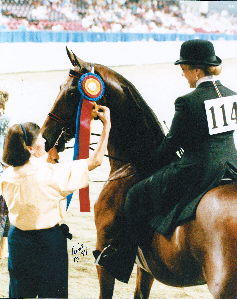
Fran Crumpler pinned the tricolor ribbon on
CH High Expectation’s bridle for Donna’s win in the
1994 Adult Equitation World’s Championship.
Fran spoke of the Tommy and CH Net Worth combination. “There’s not a horse in the world that thinks any better than that horse did. He and Tommy were a team. They didn’t even need an instructor. Put him on that horse and like magic – it just happened!”
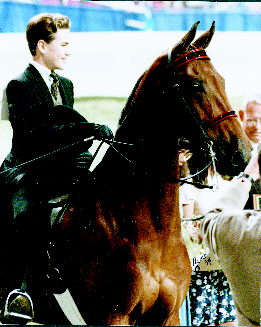
Tommy and CH Net Worth dominated the
junior saddle seat equitation division.
“A positive experience” is the way Kim described their relationship with the Pettrys and Royal Scot. “We never had a cross word. Those kids all were ‘go forward.’ Everyone always was on the same page.”
Equitation blues and tricolors continued to come the Pettrys’ way. The family purchased CH What A Memory from DeLovely in October 1995, leaving him in training with them. CH High Expectations made the move as well for Kristen to finish her equitation career with Lillian Shively. Tommy rode with his sister at DeLovely for a short period of time.
“I was crazy about Kristen and her work ethic,” Lillian Shively said. “I wish I could have had her a year longer. She was reserve in the UPHA Finals and tied pretty high in the Good Hands.”
Shively says she and Kristen “just jelled. She is a nice, kind and gentle person who reminds me of her grandmother. I thought she was beautiful on that horse. We tried to get all that done in one year and knocked at that door pretty good. It was easy for me because the family was willing to commit and give her the support she needed. That means a lot to me when a family supports their child and is with them win, lose or draw.”
Tommy finished his equitation career with the Freseths. Lynda made several trips to Arizona to work with him during the winter. Those were one of the highlights of her time with Royal Scot.
In 1996, Tommy had been showing CH What A Memory in junior exhibitor three-gaited competition. They won both the 14-17 qualifier and championship at Lexington Junior League and a reserve in the 14-17 age group at Louisville.
“CH High Expectations had gotten sick and we decided to take CH What A Memory to New York for the Good Hands Finals that year. I was in bed with a cold when it was time to go get the horse ready. Jeanne flew me to Chicago and had a limo pick me up and take me to Royal Scot Stables. I felt like Mrs. Gotrocks,” Lynda recalled. “We put that thing together really fast and he ended up fifth [in the Good Hands Finals.]”
A reserve in the 1997 Senior UPHA Challenge Cup National Finals Championship set the stage for the following season. By then, the Fergussons and Pettrys were full-time in Illinois. Their performance horses were with Kenny Smith; Tommy rode with Lynda Freseth. He finished the season as the NHS Good Hands National Finals Champion, adding a fifth in the AHSA Medal and 10th in the UPHA Medal Finals at Kansas City to his record.
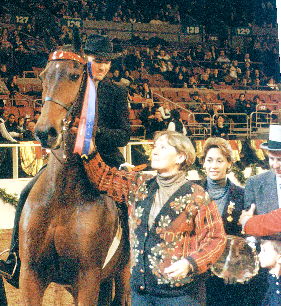
Trainer Lynda Freseth congratulated Tommy for his
1998 National Horse Show Good Hands Finals victory
aboard CH High Expectations at the National
Horse Show in Madison Square Garden.
Every trainer associated with the Fergusson and Pettry families over the years has little but good words to say about them. They share wonderful memories of watching the children grow up and of a family’s love affair with American Saddlebreds.
Freseth spoke of those days with fondness. “The whole batch came to the barn at the same time. I really enjoyed Jeanne’s being there. I’ll never forget the year Kristen, Jeanne and I flew to the Asheville Lions Club show to look at a horse. The highlight of the trip was going to the Waffle House to eat. They thought that was something!”
Fran Crumpler laughs when she recalls ‘little Tommy’ who often spent the night at their home. She remembers Easter Egg hunts with a family who lived up to the maxim ‘It’s better to give than to receive.’
“All the children are very different, very special,” she said. “Andrew just loved our bull dog. Kristen was shy, but would have a big smile when she came to see us. We knew she was glad to be out at the farm. Donna is Marge’s outgoing grandchild. She knew exactly what she wanted and had a plan. We still are very close.”
Royal Scot already had ‘reinvented itself’ when they split their lives between Richmond, Il., and Arizona. When they returned to live in Illinois full-time, Mrs. Fergusson and the Pettrys took a hard look at how the business had changed. They elected to discontinue their intensive breeding program which, at one point, included as many as 15 mares.
“We’d be lucky if we had 15 foals,” Tom Pettry explained. “They absorbed a lot of resources before they were marketable.”
When young people grow up near one another and share each other’s passions, the outcome often is inevitable. Such was the case with Donna and Kenny Smith. They began ‘seeing one another’ toward the end of the Arizona to Illinois years.
Kenny is another with Saddle Horses in his blood, even though he wouldn’t acknowledge it or get on a horse until he was 13. “My dad had built a barn in the early ’60s. Monty Wallen was there for years. I didn’t like ’em and had no time for ’em,” he said in his quiet way, adding, “I have no idea what changed my mind.”
Kenny grew up riding with Tom and Cary Volz during the years they trained at his father’s Esquire Farm. He also spent some time with the late Paul Priebe and Bill Sutton. Later, Wyatt Dehart took over training duties at the family’s Stillwater, Minn., facility.
“I’d say I learned to ride between Monty, Dad and Tom and Cary. I definitely learned more about working a horse from Bill and more than anyone from Wyatt. I worked a horse or two while I was in high school with each of them.”
Along the way, Kenny became part of Dr. Alan and Dottie Raun’s Reedannland staff. “Kenny was here about three years,” Doc Raun said. “He is an excellent trainer, very honest, hard-working and very quiet until you get to know him. When he knows you, he’s a lot of fun.
“His grandfather [Ken Smith] had horses with Paul Priebe so Kenny rode there,” Doc said. “He worked for a short period of time before coming here. That first year he was here, we didn’t get very many to shows. The second year, we won two or three Sweepstakes at Indiana. The third, we had three world’s champions.”
One of those was CH Reedann’s Phinery. The other two gaited mares were sold to Barbara Woods in Florida and Charlene Edwards in Nebraska.
If there were one horse that introduced Kenny to the Saddle Horse world at large it would be CH Champagne’s Special Event. His grandfather purchased the gelding as a two-year-old and brought him home.
“He wasn’t working out at home, so my grandfather sent him back to Mike Roberts, where he had bought him. Bill Sutton saw him at Mike’s one day. He called me and said that I needed to take the horse and work him. I told him it wasn’t up to me, so he called my grandfather and told him he had to move the horse to Doc’s. That’s how I ended up with him,” Kenny explained. “He was good to me and kind of tossed me onto the national scene.”
Tossed might be an interesting term. Doc explained, “The horse had an aversion to rings. Kenny’s granddad sent him to Reedannland. We have an outdoor ring and couldn’t make him go in. The horse grabbed the bit and tried climbing an evergreen tree. Then he ran off and got mired down. A light bulb went off. The horse realized Kenny was in charge, climbed out, got to the entrance of the ring and ran into it.
“The first time he showed at Tanbark, the horse saw the band, heard the music and spun around refusing to go in the ring. He fell down and tore up Kenny’s riding suit. Tattered suit and all, Kenny got back on him, went in the ring and won the class. His granddad told him he’d buy two suits when he could ride a horse like that,” Doc continued.
Doc says Kenny is “completely dedicated to the show horses. And he is never satisfied with his performance in the ring. I remember when he won the Junior Five-Gaited Gelding Stake at Louisville with CH Champagne’s Special Event; he came out so disappointed and downcast because the horse hadn’t done some little thing during the class. Here he was the world’s champion! It doesn’t make any difference where he places; it’s whether or not the horse makes a good show.”
CH Champagne’s Special Event won that junior stake in 1995, and tied third in the junior championship. Two years later, Kenny rode him to the Five-Gaited Geldings blue and a reserve Five-Gaited World’s Grand Championship. Kenny was 25-years-old.
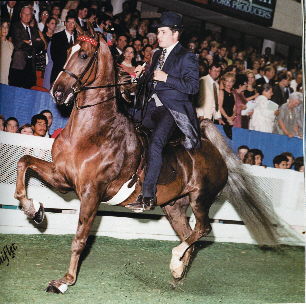
Kenny moved into the national spotlight with
his world’s championship ride aboard
CH Champagne’s Special Event in the
1997 Five-Gaited Stallion and Gelding class.
Wyatt Dehart was trainer-in-residence at the Stillwater, Minn., farm when a tornado destroyed the barn. After they rebuilt, Kenny left Reedannland to become head trainer at the family operation. He remained there until he and Donna moved back to Illinois to head the new Royal Scot program.
Neither Doc nor Dottie Raun could say enough good things about Kenny. “After he left, we occasionally sent him horses to train,” Doc said, pointing out that Intoxicating Conversation was one of those. “One time, when he was riding for us at the Des Moines Horse Show, I told the person I was with, ‘I just love that kid.’ A lady nearby said ‘so do I.’ It was his grandma.
“Kenny is straight-forward, honest as the day is long and a nice kid. He is funny but so shy. You have to get to know him before he talks your arm off.”
Callaway’s Frank James helped bring Donna and Kenny together. Scott Smith had shown the gelding successfully in the spring, Kenny stepped into the irons to win the Five-Gaited Novice title at the 1997 Tanbark Cavalcade of Roses. Jeanne took note.
“We wanted a nice gaited horse for Tommy,” Tom recalled. “Kenny already had CH Champagne’s Special Event as well as Frank James. Kenny was well-spoken; Jeanne and Marge liked all of them. I told Jeanne, ‘Why not ask Kenny? Tell him the horse is for Tommy and we want to keep it with him. Ask him which one he thinks you should buy.’”
Royal Scot’s purchase of Callaway’s Frank James, a relative unknown, was the beginning of Donna and Kenny’s close relationship. It wasn’t long before they become more than friends. Donna had planned to be an English teacher during her college years. Her talent and personality drew her into the realm of the Saddle Horse professionals.
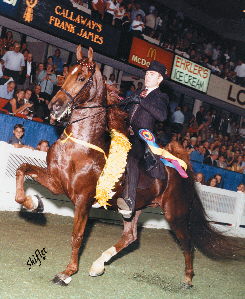
The Pettrys’ purchase of Callaway’s Frank James
helped begin their relationship with Kenny Smith.
He and Tommy won the 2000 Five-Gaited Amateur
Gentlemen’s and Amateur Five-Gaited
World’s Grand Championship.
“I think riding instruction is a natural segue from that,” she said with a smile. “I don’t think that surprised my family.”
Donna made the 600-mile plus move to Minnesota. That move and her relationship with Kenny led to the comeback of one of the more popular five-gaited champions of the decade.
Royal Scot, or more particularly Marge Fergusson, had purchased the 1993 World Grand Champion Five-Gaited horse, CH Protégé, before the 1995 season. McConnell took over his training, with Donna making her debut aboard him at Midwest. By season’s end, CH Protégé had told his owners he wasn’t happy showing any more.
“I had grown not to like him because he was the first horse I’d ever really shown that was a high-profile horse before I got him,” Donna said frankly. “We had so much trouble with him; he was a high-profile disaster. I wasn’t used to that.”
CH Protégé spent a year turned out in the field. The Pettrys had “kind of retired him.”
“When I moved to Minnesota, I took Trigger [CH Starfire Fox] with me. CH Protégé was at Royal Scot out in a field. Kenny asked what was wrong and if we would mind if he tried to put him back together. He said he wouldn’t charge anything but wanted to try. Kenny really clicked with him.”
Donna said, “1998 was a hard year. I still was trying to get over how I felt about him. CH Protégé still was high profile; it didn’t matter if he had been off for a year. He really wasn’t in top form but was hot and cold at the end of the season.”
On Wednesday, Aug. 26, CH Protégé again trotted under the lights onto the green shavings of Freedom Hall. The big, dark-chestnut gelding seemed to know where he was, what was expected of him. When Donna rode him into the arena, fans greeted him with wild enthusiasm. With 23-entries in the class, Donna faced challenges every step of the way. The judges called for 10 to remain in the ring for additional work. Again, CH Protégé rose to the challenge. When his number was called as the Ladies Five-Gaited World’s Champion, the knowledgeable crowd saluted the gelding, his rider, and trainer who brought the champion back to prominence.
Donna said, “It was very emotional for me.” So it was for all the gelding’s fans.
“In 1999, we had a great year. I was over it, CH Protégé was over it. I think we finally clicked,” Donna said.
They came to Freedom Hall with a pocket full of reserve ribbons. The ladies gelding stake had only a dozen entries. Again, Donna and Protégé made their victory pass.
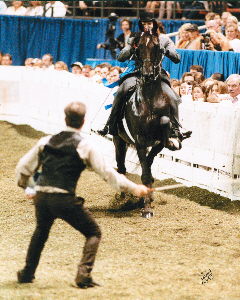
CH Protégé’s triumphant return to Freedom Hall
where he and Donna won the Ladies Five-Gaited
Gelding Stake thrilled the Royal Scot family
and his many fans
“I think that was the best class I’ve ever had with a horse. We clicked and had a great performance. The whole year was a blast for me. I didn’t care where we finished up – CH it probably was the ‘funnest’ year I’ve ever had with a horse.”
Donna and Protégé made their final appearance together in the Five-Gaited Ladies Gelding Stake at the American Royal. Again, they were the last to leave the ring.
“Kenny and I felt we were going to have to retire him as he had some soundness issues. I wanted Kenny to show him for the last time. CH Protégé finished his career as the American Royal Five Gaited Reserve Grand Champion,” Donna said.
She had moved to Minnesota where Kenny trained most of the Pettry horses. For all intents and purposes, the Richmond farm had closed. Donna and Kenny led the way into the future. Wedding plans were on the horizon.
“I wanted to elope,” Donna said candidly, explaining that a big wedding was the farthest thing from her mind. “Kenny told me, ‘Your mother and grandmother would never speak to me again if I allow that.’ We became engaged in December and married at the Downtown Marriott in Minneapolis in March. Larry Gilpin has a Justice of the Peace license; he officiated. Chris Gantley was the best man; Julie [Arnston Wroble] and Kristen were matron and maid of honor. I’m glad we did it the way we did, with all the right people present.”
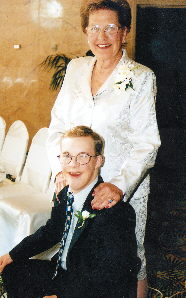
Marge Fergusson and Andrew waited together
for Donna to appear at her wedding.
Donna and Kenny’s being six hours from the rest of the Pettry family posed problems for all concerned. “Donna really wanted to move to Illinois; we moved to Illinois,” Kenny said quietly. “Ten years ago, Royal Scot was going really hard. They decided they did not need to do that. Tom wanted to do one thing, Donna another, Kristen another and Tommy still another.”
While they may have been on ‘different pages’ for a while, the Fergusson and Pettry family remains one cohesive group. They took a hard look at where they were – and where they wanted to go. The result: another Royal Scot incarnation.
“We took a 115-acre farm with barn, pasture, breeding sheds, etc., down to a 40-acre parcel,” Tom said in an earlier Horse World interview. “We have a 25-stall barn with a little different type of arena and stall set-up. All of us [other than Mrs. Fergusson] live within five minutes of one another.”
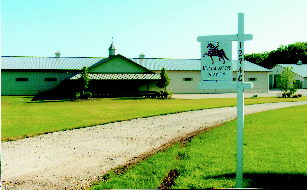
The ‘new’ Royal Scot Stables in New Lenox, Ill.
Kenny and Donna’s talents as trainers and riders already were established when they set upon their venture together. Within three years, Donna had coached Ashley Alden to the Saddle Seat Equitation World’s Grand Championship when Alden was 14.
“That win came from nowhere,” Donna said looking back. “I thought she would have to be perfect to get a ribbon. I saw the flaws in her workout; her circle wasn’t quite perfect. Now when I look back on the tape I think, ‘Good grief! That pattern was great!’ I thought a sixth place ribbon would have been great.
“My brother, sister and I all showed equitation. I fully understand what an important honor it is for my rider to win that class. I was 26 or 27 and I realize I may never win that again. A lot of great, great instructors have never won it.”
Kenny’s reputation as an outstanding horseman is well-earned. He questions whether ‘shy’ is an appropriate description of who he is.
“I don’t think I am real shy. Most people think I’m kind of a jerk because I don’t say much. A lot of people think I’m not a real pleasant person until they get to know me. If I don’t have anything to say, I don’t say it. Irrelevant conversation is tiresome.”
Another key to getting to know Kenny is to do so when he’s not as intense as he is at a show or while working a horse. In such cases, single-minded, rather than shy or curt, would be a better way to describe him.
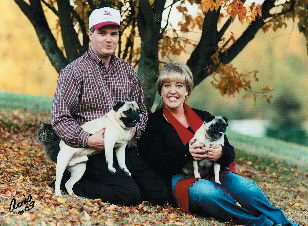
Donna and Kenny do take time to enjoy their home
and their dogs, Riggs and Shirley.
“Today, I try to work 15 to 18 head; most are not family horses. I can’t do any more and do it right; it takes me all day,” Kenny said, pointing out that he doesn’t have an assistant trainer. “I tried to go that route and it didn’t work.”
Today, all the Pettry children are adults. Kristen has taken over the farm bookwork and does a great deal of riding. She also has followed her grandfather’s example of working with the Mid-America Horse Show, of which he was president, and the Mid-America Charter Club.
Tommy stepped back from the horse show world for a couple of years. “Like a lot of kids, I aged out and went to college. I met a lot of kids outside of the horse industry when I was in Tucson. When I worked in personal training in Tucson and California, I thought about personal training and the horse industry.
“When I first started working out, I wanted to be a ‘big-muscle dude.’ That affected my riding. It made it feel a lot more cumbersome. I prefer to stay lean and at a regular body weight. Now I do c-v [cardio-vascular] training, more leg-specific stuff and exercises for my lower back. A rider’s shoulders also can give trouble.
“I think it would be kind of interesting to devise a program to help a rider,” he continued. “Equitation can be really hard on your body. The Shively kids ride all day; they have to be in great shape. Some girls are a lot shorter than others, but when they are paired up with the right horse and have great riding ability, that shines through. A good judge should be able to see that.”
Although Tommy showed but once in 2005 (at Louisville) and not at all in 2004 and ’06, he is back and living on the family farm. While he studies his career options, he is doing a pro-bono internship with the Arnstons’ nearby Country Meadow Farm. He picked up a great deal of the work when Julie Ann Wroble, the Arnstons’ daughter Tommy calls ‘a third sister,’ had to step down from training during her recent pregnancy.
Horses certainly are one major theme of the Fergusson-Pettry history. Their successes, from the beginnings of what now is Rust-Oleum and through all the Royal Scot Farm incarnations, stem from the strong Christian heritage first imparted by the intrepid Scotsman who started it all. His dedication to his God, his family and community live on through his children, grandchildren and into the fourth generation.
Giving back plays an important part in the Fergusson-Pettry lives. Much of that service and financial support is given without fanfare. Such quiet actions normally are not possible in as close-knit an industry as the show horse world. Don Fergusson set the standard with area charter clubs and local shows. When the American Saddlebred Horse Association asked Marge Fergusson to serve on its Board of Directors, she suggested Tom Pettry take her place.
Tom turned his public relations and people skills into working for and promoting American Saddlebreds. Serving first on the ASHA Board and later as its president made his name as familiar as his mother-in-law, wife and children’s to those in the show horse world. The Association recognized his contributions with its ASHA Meritorious Service Award and UPHA Associates 2002 Distinguished Service Award given at each group’s 2003 convention.
In 2005, the World’s Championship Horse Show honored Marge Fergusson with its Audrey Pugh Gutridge Sportsmanship Award. The two families’ contributions to the industry they love again came to public attention at the 2007 ASHA Convention. Marge and Tom accepted the Paul and Dorothy Gillenwater Family Award given at the annual Awards Gala in recognition a family’s sportsmanship and dedication to the American Saddlebred.
Marge says she is “very content.” She has her own ‘little’ house in Northbrook, Ill., about an hour north of the farm. She keeps up with her brothers and other family members and “has to keep up” with the horses.
“I only own one now,” she said, explaining she and Kristen are partners on Romance In New York, the 2006 Open Park Mare World’s Champion. “I like to keep up with what’s going on. All the children are part of what they always wanted to do.”
When discussing a family as high-profile as the Fergussons and Pettrys are, one will hear many comments pro and con. Persons who have worked with – not for – them often are the best judge of who such people are.
“I’ve watched some interesting children grow up,” Bonnie Byrne said. “They are a close-knit family. Marge is one of the kindest ladies, kindest people I have ever known. She is a very giving, loving person, a wonderful mother, wife and supporter of Don when they did things with the company.
“They have a very deep faith; that comes mostly from Jeanne. She doesn’t waver but is an evangelist in her own right. The children grew up with those values. Sometimes they may not show, but they are in them, no matter what.”
McAbee took it a step further. “The years the kids won all those championships and stuff were really special for them. They put so much into this; I felt it very right they should have success.
“I was always behind the scenes. I heard a lot of what people said. I know these people are the real deal. They had money to do this, still they put their emphasis on where it should have been. They’re a very unique family that has stuck together. That’s important these days.”
That Scottish sea captain would be very – if not proud – grateful.
|